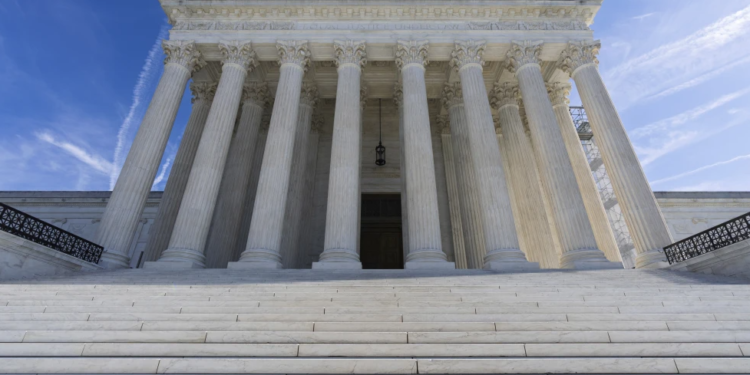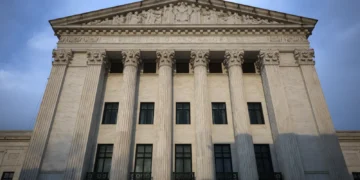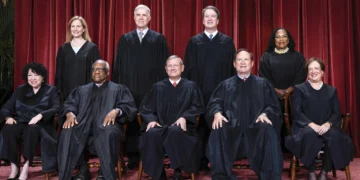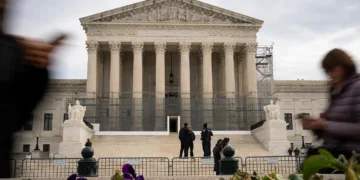August 1, 2025 Story by: Publisher
The U.S. Supreme Court will hear re-arguments in the case of Louisiana’s congressional maps on Wednesday, October 15. This comes after the highest court in the land paused on ruling on the case in the previous term, which ended in June.
“Does the State’s intentional creation of a second majority‑minority congressional district violate the Fourteenth or Fifteenth Amendments to the U.S. Constitution?“
If the justices determine Louisiana violated the constitution with its latest congressional map, it could undermine the Voting Rights Act. The legislation was approved in 1965 to bolster the protections granted in the 14th and 15th Amendments. It has been amended five times since then to strengthen its provisions, though voting rights advocates note federal court rulings over the past decade have chipped away at the law.
At question in the Callais case is Section 2 of the Voting Rights Act, which prohibits voting laws or procedures that purposefully discriminate on the basis of race, color or membership in a language minority group.
In late June, Justice Clarence Thomas warned that the Court is overstepping its role and undermining legislatures attempting to uphold federal voting rights law. In a sharply worded dissent from the Supreme Court’s decision to delay the resolution of Louisiana’s second majority-Black congressional district.
He argues that judicial skepticism toward race-conscious redistricting—especially when crafted to comply with the Voting Rights Act—risks eroding protections for minority representation and entangling courts in overtly political disputes.
“These cases are restored to the calendar for reargument,” the Court notes, leaving open the possibility of a precedent-shifting ruling next term that could redefine the boundaries of lawful redistricting nationwide. “In due course, the Court will issue an order scheduling argument and specifying any additional questions to be addressed in supplemental briefing.”
The U.S. Supreme Court announced a decision to delay final judgment on Louisiana’s congressional map ordering new arguments in the fall. The decision effectively paused a high-stakes legal battle over voting rights, racial representation, and political power in one of the Deep South’s most heavily gerrymandered states.
At the heart of the case lies the question of whether Louisiana must preserve a second majority-Black congressional district—a pivotal issue that reshapes the state’s political landscape and may alter the balance of power in the U.S. House during the 2026 midterms.
Why This Case Raises Historic Stakes
The decision places front and center the tension between:
- Section 2 of the Voting Rights Act (VRA) — which requires fair representation for minority voters when geography and demographics allow.
- The Equal Protection Clause of the 14th Amendment and the 15th Amendment’s ban on racial discrimination in voting rights.
Supporters argue the new district remedies a violation of the VRA. Detractors claim any map drawn primarily on racial lines—even for that reason—undermines constitutional colorblindness.
Case Background
The U.S. Supreme Court announced a decision to delay final judgment on Louisiana’s congressional map ordering new arguments in the fall. The decision effectively pauses a high-stakes legal battle over voting rights, racial representation, and political power in one of the Deep South’s most heavily gerrymandered states.
At the heart of the case lies the question of whether Louisiana must preserve a second majority-Black congressional district—a pivotal issue that reshapes the state’s political landscape and may alter the balance of power in the U.S. House during the 2026 midterms.
The lawsuit, brought by civil rights groups and Black voters, challenges the Republican-controlled Louisiana Legislature’s post-2020 census map, which maintains just one majority-Black district out of six, despite the fact that Black residents make up nearly one-third of the state’s population.
After the 2020 census, Louisiana needed to draw a new map for its six congressional districts. Although roughly a third of the state’s population is Black, the map that the legislature enacted in 2022 contained only one majority-Black district.
A group of Black voters challenged that map, arguing that it diluted the votes of Black residents. A federal court agreed that it likely violated Section 2 of the Voting Rights Act, which prohibits election practices that result in a denial or abridgment of the right to vote. It instructed the state to draw a new map with a second majority-Black district and barred the state from using the existing map.
The U.S. Court of Appeals for the 5th Circuit upheld that ruling and instructed Louisiana to draw a new map by Jan. 15, 2024. Without a new map by then, the court of appeals said, the district court would hold a trial and, if necessary, adopt a map for the 2024 elections.
The legislature drafted a new map, known as S.B. 8, with a second majority-Black district that begins in the northwest corner of the state near Shreveport and stretches 250 miles southeast toward Baton Rouge.
The “non-African American” voters then challenged S.B. 8. A three-judge federal district court ruled that the creation of the second majority-Black district was an unconstitutional racial gerrymander, and it barred the state from using the map in the 2024 elections.
In 2022, a federal district court found the map to be racially discriminatory and ordered the state to draw a second majority-Black district.
A divided Supreme Court put the three-judge court’s decision on hold in May, allowing the state to use the map during the 2024 elections, and in November it set the appeal by the state and the Black voters for argument.
Louisiana officials, led by Republican Attorney General Liz Murrill, appealed, arguing that race was given too much weight in the court’s redistricting mandate, and that such race-conscious remedies risk violating the Equal Protection Clause. Their legal team contends that a second Black-majority district would require impermissible racial gerrymandering.
During oral arguments earlier this year, several justices pressed both sides on the constitutional and statutory boundaries of race in redistricting. The case arrives in the shadow of last year’s Allen v. Milligan decision, in which the Court upheld a similar order in Alabama. That precedent looms large, but with one-third of the docket still undecided and conservative justices signaling unease with federal court interventions, it remains unclear how closely the Court will hew to its 2023 ruling.
A Louisiana legislative committee on May 28, 2025 voted to reject two bills that would have added eight new majority-Black districts to the state House and Senate.
The proposals, introduced by Rep. Edmond Jordan (D‑Baton Rouge), chairman of the Legislative Black Caucus, would have redrawn the 39‑seat Senate map and 105‑seat House map to create more Black-majority districts.
Both measures failed on party-line votes: House Bill 487 (Senate districts) was defeated 9–6, and HB 488 (House districts) fell 9–5. As a result, Louisiana’s legislative boundaries remain unchanged this session, though lawmakers could revisit redistricting in a future legislative session.
What the Order Means
The Supreme Court’s new directive requires parties to address whether Legislature’s intentional draw of a second majority‑minority district can legally survive scrutiny under the 14th or 15th Amendments. This is unusual; the Court is not just reviewing Section 2 compliance—it’s questioning the constitutionality of remedial redistricting rooted in race.
Timeline & Next Steps
The Court has set a structured timeline for the next phase of the case:
Briefs from the State of Louisiana and Black voters are due on or before Wednesday,August 27, 2025.
The plaintiff, representing non-Black voters, must file their brief due on or before September 17, 2025.
All reply briefs are due on or before 2 p.m., Friday, October 3, 2025.
New oral arguments are expected to be scheduled during the Court’s 2025–26 term, with a final decision likely to be issued by June 2026.
Why This Matters
- If the Court rules that a state’s remedial use of race violates constitutional norms, it could undermine decades of Voting Rights Act jurisprudence.
- The Louisiana case stands to reshape the guardrails for redistricting nationwide—including in states with growing minority populations.
- Advocacy organizations warn this ruling may be the most consequential VRA case since Shelby County v. Holder (2013).
Bottom Line
The Supreme Court’s expanded scope in Louisiana v. Callais signals a dramatic moment on the horizon for voting rights law. As the Court wrestles with whether race can play an intentional, remedial role in redistricting, the outcome may redefine how—and whether—states can use Section 2 to ensure fair minority representation without running afoul of constitutional mandates.
Source: Louisiana Illuminator / Politico / Reuters / The Washington Post
















